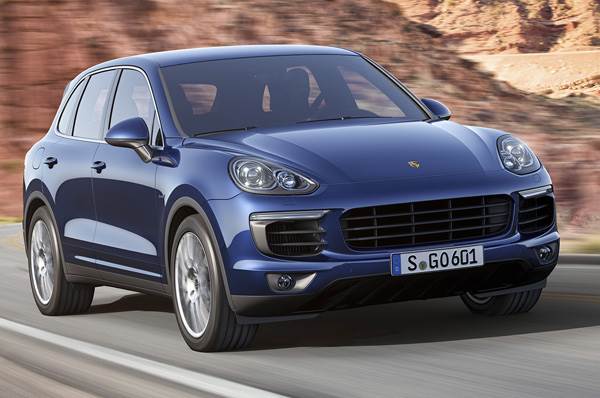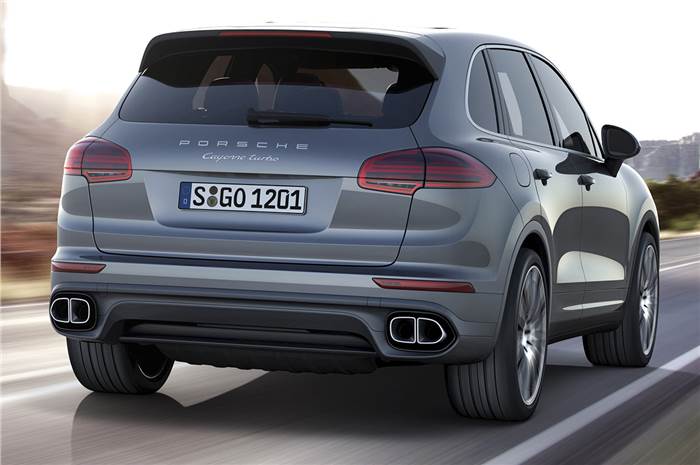A facelifted version of the strong selling second-generation Porsche Cayenne, for the international markets, has been revealed ahead of a planned public debut at the Paris motor show in October.
Included as part of the updated range is a new 410bhp petrol-electric S E-Hybrid model that is claimed to offer a 0-100kph time of 5.9sec. That's alongside a 243kph top speed and a zero-emission electric range of up to 35.4km at up to 125.5kph. The reworked Cayenne further benefits from a series of exterior and interior design changes that bring it in line with the manufacturer's current cars. There's also a range of reworked petrol and diesel engines allied to new fuel saving technology – all aimed at providing it with fresh appeal.
The mid-life styling changes appear subtle but bring some significant changes to the front-end design of the Cayenne. Updates include a larger grille, a new bumper with additional blades within the air ducts for more efficient cooling of the intercoolers, redesigned front wings and a larger bonnet boasting subtle contouring. More angular headlights, with standard Xenon main beams (LED with Porsche Dynamic Light System on the top-of-the-line Turbo), are fitted to the new Cayenne too.
At the rear there are revised tail-lights that, like the headlights, adopt a more angular shape. The number plate recess and boot opening mechanism now also blends more elegantly into the tailgate. Porsche's design team has also added a revised bumper with integrated tailpipes. Changes inside include a new multi-function steering wheel with shift paddles modeled on that used in the 918 Spyder, which come as standard equipment together with a more contoured rear seat that now comes with optional ventilation.
Heading the long list of efficiency boosting features brought to the facelifted Cayenne is a new coast function as well as improved version of the existing model’s stop/start system – both of which have been integrated into its standard eight-speed automatic gearbox. Further innovations include active air flaps located behind the grille. They open or close depending on the cooling requirements for the engine, constantly adjusting the volume of air entering the engine bay and helping to reduce aerodynamic drag.
New to the Cayenne line-up is the S E-Hybrid, which replaces the S Hybrid. It runs the same Audi-engineered supercharged 3.0-litre V6 direct injection petrol engine as its predecessor. With 328bhp and 45kgm of torque, it is mated to a new electric motor that develops 94bhp. Altogether, Porsche’s third dedicated plug-in hybrid model, after the 918 Spyder and Panamera S E-Hybrid, delivers a combined output of 410bhp at 5500rpm and 60kgm of torque between 1200 and 4000rpm, improving on the model it replaces by 35bhp and 9.8kgm.
In further changes, Porsche has replaced the naturally aspirated 4.8-litre V8 direct injection petrol engine in the Cayenne S with a new twin-turbocharged 3.6-litre V6 direct injection petrol unit from the recently introduced Macan Turbo. With 414bhp at 6000rpm and 56kgm of torque, the new unit delivers an added 20bhp and 5.11kgm, providing the Cayenne S with a 0.5sec improvement in its 0-100kph time at 5.4sec, together with an incremental increase in top speed at 259kph.
Further up the range, the Cayenne Turbo gains a more powerful version of Porsche’s turbocharged 4.8-litre V8 direct injection petrol engine developing an added 20bhp at 512bhp and an extra 5.11kgm of torque at 553lb ft. Its 0-100kph time is reduced by 0.3sec to an official 4.4sec, while top speed increases by to 280kph. Porsche has also increased the output of the 3.0-litre V6 common rail diesel engine in the Cayenne Diesel. It now produces 258bhp at 6000rpm and 59kgm of torque between 1750 and 2500rpm. The subtle bump in reserves cuts 0.3sec from the 0-100kph time to 7.2sec, while top speed extends to 220kph.
Even milder are the changes brought to the Cayenne S Diesel. Its turbocharged 4.2-litre V8 common rail diesel engine gains 3bhp, taking its output up to 380bhp. The slight increase in power combines with the efficiency gains to the gearbox to reduce the 0-100kph time by 0.4sec to 5.3sec while retaining the previous model’s 253kph top speed.
Together with the myriad engine changes, Porsche says it has fined tuned the Cayenne’s chassis to provide what it describes as a “greater spread between comfort and sportiness”.




Comments
Member Login
Personal Details
No comments yet. Be the first to comment.